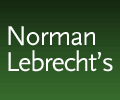Originally, the CBC scheduled extensive classical music
programming on both of its AM radio networks, Radio One and Premiere Chaine.
Today''s Radio Two originally started in the mid-1970s with only five FM Stations
(Montreal, Ottawa, Toronto, Winnipeg, and Vancouver) while La Cha?ne Culturelle
began with just two stations (Montreal and Ottawa).
However, in the mid-1980s the program director of English
CBC Radio, Margaret Lyons, announced a profound change in the traditional
methods and practices of carrying classical music on its airwaves, decreeing:
"There''s too much classical music on CBC radio." This angered long-time staffers
and listeners alike. Nevertheless, today CBC Radio One is now mostly talk;
classical music is only heard from 10:00 pm to 1:00 am. While most areas of
Canada can receive Radio Two or La Cha?ne Culturelle, there are still large
sections of the country where neither of these networks is available. The
impending restructuring of the CBC radio programming under new program director
Adrian Mills may see a change in classical music on Radio One. The CRTC has
recently authorized the Soci?t? Radio-Canada to establish new stations for La
Cha?ne Culturelle across the country.
On the private front
Meanwhile, several privately owned classical FM stations
have begun operations in the last 20 years. In Toronto, CFMX-FM Classical 96 has
two transmitters, at 96.3 and 103.1, while in Montreal, CJPX-FM
Radio-classique-Montreal has been operating at 99.5 with remarkable success.
According to Claude Dufault, an executive with Radio-Nord, CHLX-FM at 97.1 on
the Ottawa dial will commence operation around 15 September 2002 with a library
of 30,000 classical CDs. Approval of Radio-Nord''s application for another
classical license in Quebec City is expected shortly (CJJX-FM at 91.9 could open
in early 2003). Furthermore, Radio-Nord is preparing, in partnership with an
executive of the Montreal Jazz Festival, an application to the CRTC for a
24-hour smooth jazz station on an unused FM frequency previously allocated to
the Montreal area. In competition is Canwest Global who has just received
permission from the CRTC for a smooth jazz station in Winnipeg in 2003.
Meanwhile, the hours of 9:00 pm to midnight will be allotted to a smooth jazz
program on the new CHLX-FM in Ottawa, joining perhaps the only other operating
smooth jazz station in Canada, one in the Hamilton, Ontario area, at 94.7
FM.
The commercial pull
Commercial radio broadcasters have always been driven to
attract advertising revenue for owners and shareholders. This has led to the
demise of several good American classical FM stations in favour of more
lucrative popular formats, in such cities as Detroit, Albuquerque, Atlanta,
Syracuse, and Chicago. In comparison, the state of classical FM commercial radio
in Canada looks very bright. Classical 96 in Toronto over the last two years has
seemingly adopted Radio-classique''s "easy classical listening" mode--by reducing
talk.
Conclusion
Audiences for classical music are everywhere, not just in
the bigger urban centres. The CRTC should allow both the CBC and private
broadcasters to expand their operations as rapidly as possible. In the days
before television, all major American and Canadian radio stations had network
transmissions available if they wished to broadcast an affiliated program. The
CBC still makes use of this method of broadcasting, as do NPR (National Public
Radio) and PRI (Public Radio International) in the United States. It is also a
good method for private broadcasters to save on program production expenses yet
still offer programs featuring symphony orchestras and opera companies. For
example, the Metropolitan Opera Company in New York continues to be heard as the
"Saturday Afternoon at the Opera" on the CBC.
?Major concert fixtures such as the Festival de Lanaudi?re
and the Montreal International Jazz Festival feature performances that would
fill the requirements of network radio admirably. Toronto''s CFMX and Montreal''s
CJPX each have a listenership of over 440,000 people, a number that continues to
grow. In the United Kingdom, Classic FM has overtaken the BBC''s Radio Three in
listenership.
So the substantial audience for classical FM radio can no
longer be denied. Further, broadcast wavelengths are public property in Canada.
Thus classical and jazz listeners may rightfully demand that the broadcasting
industry serve their requirements better than is done now-- and not just serve
those who listen to popular and country formats. *
Some privately owned classical FM radio stations in the
USA and Canada



